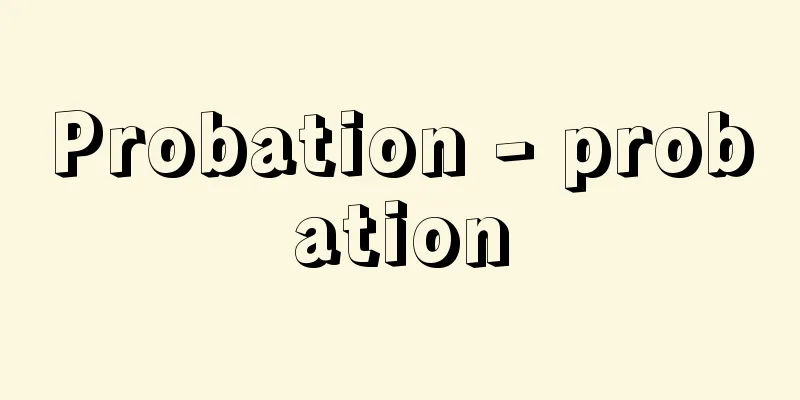Edo prosperity record

|
A Chinese comedy from the late Edo period. Written by Terakado Seiken. Five volumes in five books. Published between 1832 and 1836 (Tenpo 3-7). The sixth volume was published in 1841 as "Edo Hanjo Kōki: Seirō no Maki." The first and second volumes of "Edo Hanjo Kōki," which continues from volume 5, were published in 1878 (Meiji 11). This work was started as a means of making a living for a ronin Confucian scholar, and was a big hit with its novel attempt to lightheartedly describe the hustle and bustle of the Edo world, such as sumo, Yoshiwara, and the smoking of the Ryogoku area, in classical Chinese. However, the author's innate sarcastic eye and critical spirit made it a rare piece of literature in the Edo period that satirized reality. As a result, the first and second volumes were banned in 1835, but he continued to publish the third volume and beyond. As a result, during the Tenpo Reforms (1841-43), the author was finally punished by the samurai servants' police, and the thorough satire of reality, "Edo Hanjo Kōki," could only be published under the new Meiji government. In the late Edo and Meiji periods, a genre of literature called "Hanjokimono" (Records of Prosperity), inspired by the popularity of this work, was created. [Mitsutoshi Nakano] "The Edo Hanjo-ki" (annotated by Haruhiko Asakura and Kikuji Ando) in 3 volumes (Heibonsha, Toyo Bunko) First volume: Terakado Seiken, published in 1832 (Tenpo 3), held at the National Diet Library "Record of Edo's Prosperity" Source: Shogakukan Encyclopedia Nipponica About Encyclopedia Nipponica Information | Legend |
|
江戸後期の漢文戯作(げさく)。寺門静軒(てらかどせいけん)著。5編5冊。1832~36年(天保3~7)刊。さらに第6編は『江戸繁昌後記青楼之巻(せいろうのまき)』として41年刊。また第5編を書き継いだ『江戸繁昌後記』は初編・2編が78年(明治11)に刊行。浪人儒者の生活の資とするために書き始められた本書は、相撲(すもう)、吉原、両国烟火(はなび)といったぐあいに江戸の世俗の繁華を漢文で戯(ざ)れ書きするという新しい試みに大当りをとるが、作者生まれつきの皮肉な目と批判精神により、江戸期には希有(けう)の現実風刺の文学ともなり、そのために初編・2編がまず1835年に発禁処分を受け、懲(こ)りずに3編以下を刊行したため、天保(てんぽう)の改革(1841~43)にあたって作者はついに武家奉公御構(おかま)いの処分を受け、現実風刺の徹底した『江戸繁昌後記』は明治の新政府の下でなければ刊行しえないこととなった。幕末・明治期には本書の評判に倣って、「繁昌記もの」とよばれる一分野ができたほどである。 [中野三敏] 『朝倉治彦・安藤菊二校注『江戸繁昌記』全3巻(平凡社・東洋文庫)』 初編 寺門静軒著 1832年(天保3)刊国立国会図書館所蔵"> 『江戸繁昌記』 出典 小学館 日本大百科全書(ニッポニカ)日本大百科全書(ニッポニカ)について 情報 | 凡例 |
>>: Edo Shogunate Diary - Edo Shogunate Diary
Recommend
Butt of a tree
〘noun〙① The bottom end of a tree. The part of timb...
Bribery by fraud - ouhoushuwaizai
...(5) A person who accepts a bribe for himself o...
Inanna
A Sumerian goddess. Some of her characteristics we...
Ezukushi - Ezukushi
A booklet with a set theme and a collection of pic...
Abe Jack - Abe Jack
…Abe Jack, a film director known affectionately a...
Derived Demand
This is the demand that arises as a result of the ...
Accent - Accent (English spelling)
It comes from the Latin accentus, originally a Gr...
Japan Weather Association - Nihonkishokyokai (English)
A foundation that provides weather information ser...
Dzungaria
A region in the northeastern part of the Xinjiang ...
Sangallo, Francesco da
Born: 1494. Florence [Died] 1576. Florentine Itali...
Dewey, John
Born October 20, 1859 in Burlington, Vermont [Died...
Mithradates II
…Reigned 124 or 123 BC - 88 or 87 BC. Also known ...
《Conference of the Gods》
…Soviet filmmakers assisted in the reconstruction...
Sympathetic Eye - Kikōkangan
...Behcet's disease and Harada's disease ...
mahr
...In the case of death, the couple must be reuni...









